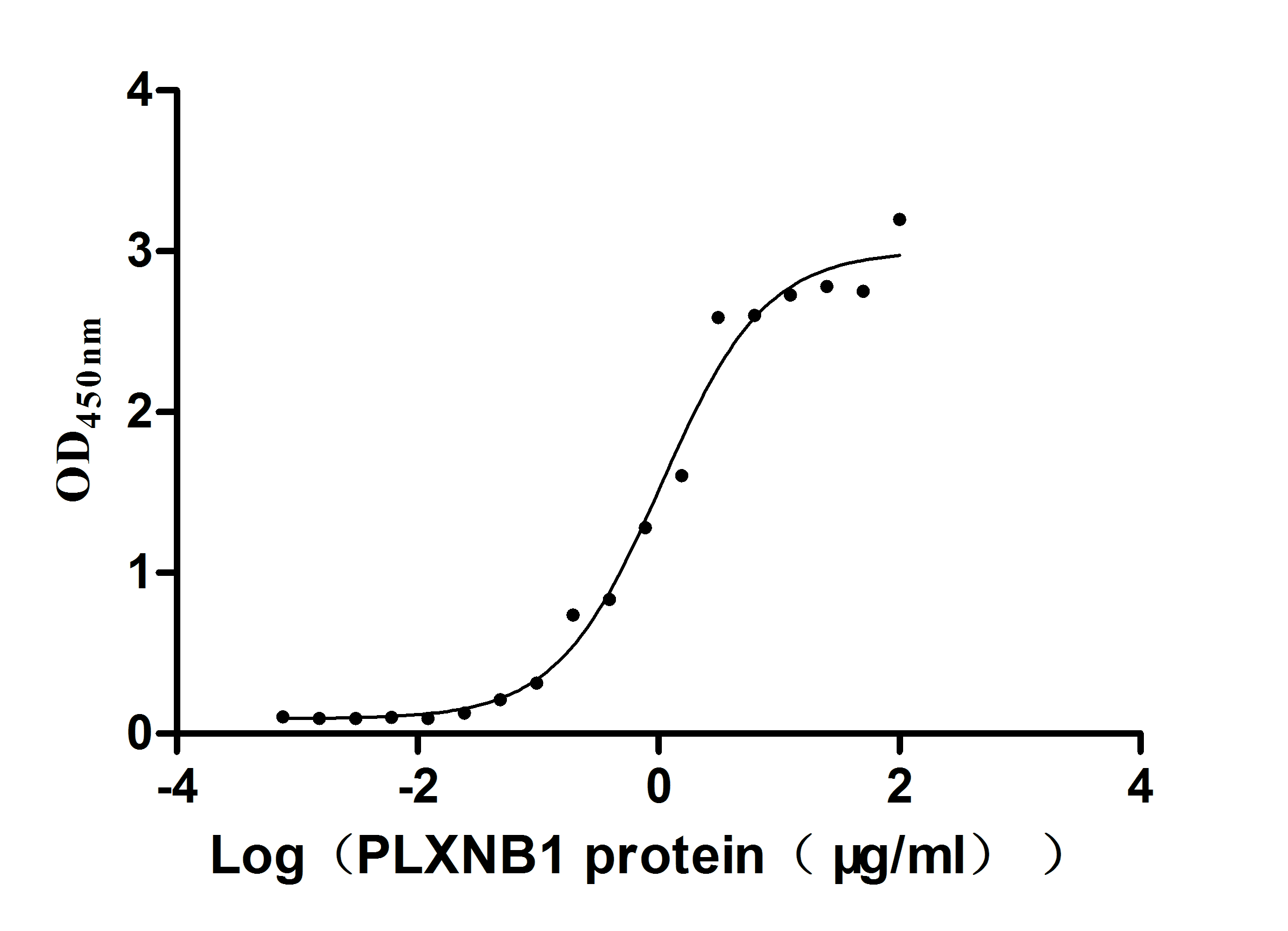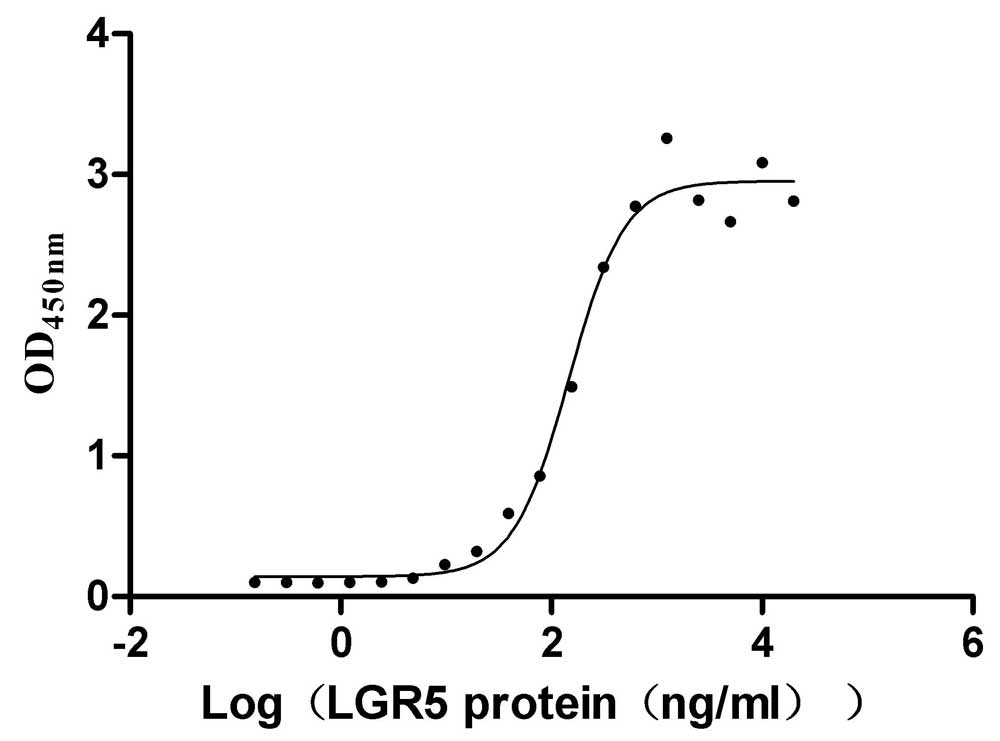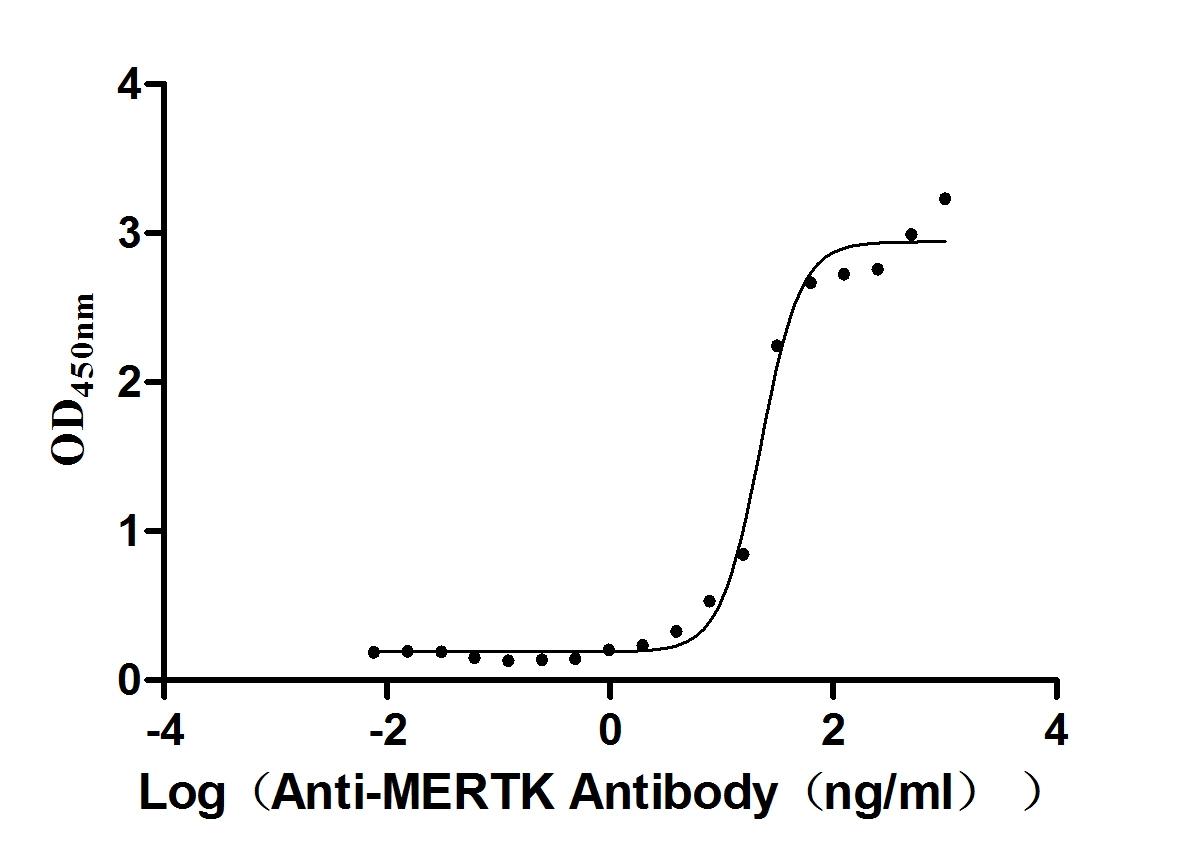Recombinant Mouse Angiopoietin-related protein 3 (Angptl3)
-
货号:CSB-YP874172MO
-
规格:
-
来源:Yeast
-
其他:
-
货号:CSB-EP874172MO-B
-
规格:
-
来源:E.coli
-
共轭:Avi-tag Biotinylated
E. coli biotin ligase (BirA) is highly specific in covalently attaching biotin to the 15 amino acid AviTag peptide. This recombinant protein was biotinylated in vivo by AviTag-BirA technology, which method is BriA catalyzes amide linkage between the biotin and the specific lysine of the AviTag.
-
其他:
-
货号:CSB-BP874172MO
-
规格:
-
来源:Baculovirus
-
其他:
-
货号:CSB-MP874172MO
-
规格:
-
来源:Mammalian cell
-
其他:
产品详情
-
纯度:>85% (SDS-PAGE)
-
基因名:
-
Uniprot No.:
-
别名:Angptl3Angiopoietin-related protein 3; Angiopoietin-like protein 3) [Cleaved into: ANGPTL3(17-224)]
-
种属:Mus musculus (Mouse)
-
蛋白长度:Full Length of Mature Protein
-
表达区域:17-455
-
氨基酸序列SRVD PDLSSFDSAP SEPKSRFAML DDVKILANGL LQLGHGLKDF VHKTKGQIND IFQKLNIFDQ SFYDLSLRTN EIKEEEKELR RTTSTLQVKN EEVKNMSVEL NSKLESLLEE KTALQHKVRA LEEQLTNLIL SPAGAQEHPE VTSLKSFVEQ QDNSIRELLQ SVEEQYKQLS QQHMQIKEIE KQLRKTGIQE PSENSLSSKS RAPRTTPPLQ LNETENTEQD DLPADCSAVY NRGEHTSGVY TIKPRNSQGF NVYCDTQSGS PWTLIQHRKD GSQDFNETWE NYEKGFGRLD GEFWLGLEKI YAIVQQSNYI LRLELQDWKD SKHYVEYSFH LGSHETNYTL HVAEIAGNIP GALPEHTDLM FSTWNHRAKG QLYCPESYSG GWWWNDICGE NNLNGKYNKP RTKSRPERRR GIYWRPQSRK LYAIKSSKMM LQPTT
-
蛋白标签:Tag type will be determined during the manufacturing process.
The tag type will be determined during production process. If you have specified tag type, please tell us and we will develop the specified tag preferentially. -
产品提供形式:Lyophilized powder
Note: We will preferentially ship the format that we have in stock, however, if you have any special requirement for the format, please remark your requirement when placing the order, we will prepare according to your demand. -
复溶:We recommend that this vial be briefly centrifuged prior to opening to bring the contents to the bottom. Please reconstitute protein in deionized sterile water to a concentration of 0.1-1.0 mg/mL.We recommend to add 5-50% of glycerol (final concentration) and aliquot for long-term storage at -20℃/-80℃. Our default final concentration of glycerol is 50%. Customers could use it as reference.
-
储存条件:Store at -20°C/-80°C upon receipt, aliquoting is necessary for mutiple use. Avoid repeated freeze-thaw cycles.
-
保质期:The shelf life is related to many factors, storage state, buffer ingredients, storage temperature and the stability of the protein itself.
Generally, the shelf life of liquid form is 6 months at -20°C/-80°C. The shelf life of lyophilized form is 12 months at -20°C/-80°C. -
货期:Delivery time may differ from different purchasing way or location, please kindly consult your local distributors for specific delivery time.Note: All of our proteins are default shipped with normal blue ice packs, if you request to ship with dry ice, please communicate with us in advance and extra fees will be charged.
-
注意事项:Repeated freezing and thawing is not recommended. Store working aliquots at 4°C for up to one week.
-
Datasheet :Please contact us to get it.
相关产品
靶点详情
-
功能:Acts in part as a hepatokine that is involved in regulation of lipid and glucose metabolism. Proposed to play a role in the trafficking of energy substrates to either storage or oxidative tissues in response to food intake. Has a stimulatory effect on plasma triglycerides (TG), which is achieved by suppressing plasma TG clearance via inhibition of LPL activity; the function seems to be specific for the feeding conditions. The inhibition of LPL activity appears to be an indirect mechanism involving recruitment of proprotein convertases PCSK6 and FURIN to LPL leading to cleavage and dissociation of LPL from the cell surface; the function does not require ANGPTL3 proteolytic cleavage but seems to be mediated by the N-terminal domain, and is not inhibited by GPIHBP1. Can inhibit endothelial lipase, causing increased plasma levels of high density lipoprotein (HDL) cholesterol and phospholipids; the cleaved N-terminal domain is more efficient than the uncleaved proprotein. Can bind to adipocytes to activate lipolysis, releasing free fatty acids and glycerol. Suppresses LPL specifically in oxidative tissues which is required to route very low density lipoprotein (VLDL)-TG to white adipose tissue (WAT) for storage in response to food; the function may involve cooperation with circulating, liver-derived ANGPTL8 and ANGPTL4 expression in WAT. Contributes to lower plasma levels of low density lipoprotein (LDL)-cholesterol by a mechanism that is independent of the canonical pathway implicating APOE and LDLR. May stimulate hypothalamic LPL activity.; Involved in angiogenesis. Binds to endothelial cells via integrin alpha-V/beta-3 (ITGAV:ITGB3), activates FAK, MAPK and Akt signaling pathways and induces cell adhesion and cell migration. May increase the motility of podocytes. Secreted from podocytes, may modulate properties of glomerular endothelial cells involving integrin alpha-V/beta-3 and Akt signaling. May induce actin filament rearrangements in podocytes implicating integrin alpha-V/beta-3 and Rac1 activation. Binds to hematopoietic stem cells (HSC) and is involved in the regulation of HSC activity probably implicating down-regulation of IKZF1/IKAROS.
-
基因功能参考文献:
- The role of ANGPLT3 in controlling lipoprotein metabolism and risk of cardiovascular diseases is reviewed here. PMID: 29334984
- ANGPTL8 has a functional LPL inhibitory motif, but only inhibits LPL and increases plasma TG levels in mice in the presence of ANGPTL3 PMID: 28413163
- The data suggests that ANGPTL3 is part of the machinery causing dyslipidemia majorily via LPL inhibition in mastitis mice. PMID: 29104012
- Using in vitro ketosis model by glucose starvation, studied inhibition of ketosis by momilactone B. Found momilactone B could regulate the angiopoietin-like-3 (ANGPTL3)-lipoprotein lipase (LPL)pathway, and suppressed the expression of HMGCS2 through the increased expression of STAT5b. PMID: 27874312
- This model suggests a general mechanism by which TAG trafficking is coordinated by lipasin, Angptl3 and Angptl4 at different nutritional statuses. PMID: 26687026
- Inactivation of ANGPTL3 reduces hepatic VLDL-triglyceride secretion PMID: 25954050
- The deletion of ANGPTL3 tremendously attenuates proteinuria and protects podocytes from injury in a mouse model of adriamycin-induced nephropathy. PMID: 25710887
- ANGPTL3 has a role in regulating white adipose tissue energy homeostasis but not in liver PMID: 26305978
- Data indicate that expression of Angptl3 in hematopoietic stem cell (HSC) through lentiviral transduction promoted HSC expansion. PMID: 25170927
- Angptl3 could induce actin filament rearrangement, mainly in lamellipodia formation, and that this process was mediated by integrin alpha(V)beta-mediated FAK and PI3K phosphorylation and Rac1 activation. PMID: 24294595
- Furin has a role as the primary in vivo convertase of ANGPTL3 and endothelial lipase in hepatocytes PMID: 23918928
- ANGPTL8, a paralog of ANGPTL3 that arose through duplication of an ancestral DOCK gene, regulates postprandial TAG and fatty acid metabolism by controlling activation of its progenitor, and perhaps other ANGPTLs PMID: 23150577
- Angptl3, as an extrinsic factor, thus supports the stemness of hematopoietic stem cells in the bone marrow niche. PMID: 20959605
- ANGPTL3 expression is upregulated in puromycin-induced podocyte damage and is associated with the reduction of perlecan and agrin expression PMID: 20424482
- a molecular connection between ANGPTL3, lipoprotein lipase, and proprotein convertases PMID: 20581395
- ANGPTL3 to be capable of regulating the motility and permeability of podocytes and that the mechanism of ANGPTL3's regulation could be associated with the altered expression of nephrin. PMID: 20633534
- Like ANGPTL4, ANGPTL3 inhibited nonstabilized LPL but not GPIHBP1-stabilized LPL PMID: 19542565
- ANGPTL3 stimulates endothelial cell adhesion and migration via integrin alpha vbeta 3 and induces blood vessel formation in vivo PMID: 11877390
- affects VLDL triglyceride clearance by interfering with LPL activity PMID: 12097324
- hepatic Angptl3 has a role in hypertriglyceridemia associated with the treatment of LXR ligand PMID: 12672813
- the cleavage of ANGPTL3 at two sites is important for the activation of ANGPTL3 in vivo PMID: 12909640
- Expression of ANGPTL3 was enhanced in both insulin-deficient and -resistant diabetic states; results strongly suggest ANGPTL3 to play an important role in hyperlipidemia in diabetes. PMID: 15094378
- Elevated ANGPTL3 by leptin- or insulin-resistance is attributed to increased plasma triglycerides and free fatty acid levels in obesity. PMID: 15336575
- Differential regulation of Angptl3 and Angptl4 by sites of expression, nutritional status, and ligands of nuclear receptors may confer unique roles of each in lipoprotein metabolism. Angptl3 is a target gene of liver X receptor PMID: 15863837
- Angptl3-deficiecy displayed hypotriglyceridemia with elevated postheparin plasma lipoprotein lipase, with greater effect in fed state. Deficiecy in both Angptl proteins had additive effect on plasma triglycerides with survival not past 2 months of age. PMID: 16081640
- Angptl3 acts as an inhibitor of EL and may be involved in the regulation of plasma HDL cholesterol and HDL-PL levels in humans and rodents. PMID: 17110602
- SE1 region of ANGPTL3 and ANGPTL4 functions as a domain important for binding LPL and inhibiting its activity in vitro and in vivo. PMID: 19318355
显示更多
收起更多
-
亚细胞定位:Secreted. Cell projection, lamellipodium.
-
组织特异性:Predominantly expressed in liver, weakly expressed in kidney and lung. Expressed in podocytes (at protein level). Expressed in hypothalamic neurons (at protein level). Expressed in bone marrow sinusoidal endothelial cells (at protein level).
-
数据库链接:
KEGG: mmu:30924
STRING: 10090.ENSMUSP00000030280
UniGene: Mm.28341
Most popular with customers
-
Recombinant Human Plexin-B1 (PLXNB1), partial (Active)
Express system: Mammalian cell
Species: Homo sapiens (Human)
-
Recombinant Human R-spondin-1 (RSPO1), partial (Active)
Express system: Mammalian cell
Species: Homo sapiens (Human)
-
Recombinant Mouse Tyrosine-protein kinase Mer (Mertk), partial (Active)
Express system: Mammalian cell
Species: Mus musculus (Mouse)
-
Recombinant Human Microtubule-associated protein tau (MAPT) (Active)
Express system: Mammalian cell
Species: Homo sapiens (Human)
-
Recombinant Human C-C chemokine receptor type 8 (CCR8)-VLPs (Active)
Express system: Mammalian cell
Species: Homo sapiens (Human)
-
Recombinant Human Killer cell immunoglobulin-like receptor 3DL2 (KIR3DL2), partial (Active)
Express system: Mammalian cell
Species: Homo sapiens (Human)
-
Recombinant Human CD70 antigen (CD70), partial (Active)
Express system: Mammalian cell
Species: Homo sapiens (Human)
-
Recombinant Macaca fascicularis C-type lectin domain family 4 member C(CLEC4C), partial (Active)
Express system: Mammalian cell
Species: Macaca fascicularis (Crab-eating macaque) (Cynomolgus monkey)





-AC1.jpg)














